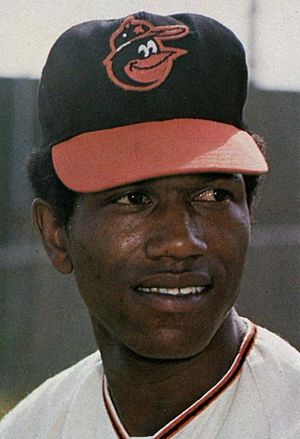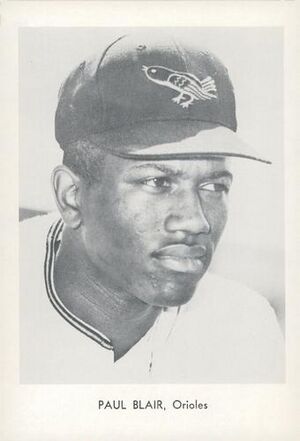Paul Blair (baseball) facts for kids
Quick facts for kids Paul Blair |
|||
|---|---|---|---|
 |
|||
| Center fielder | |||
| Born: February 1, 1944 Cushing, Oklahoma |
|||
| Died: December 26, 2013 (aged 69) Baltimore, Maryland |
|||
|
|||
| debut | |||
| September 9, 1964, for the Baltimore Orioles | |||
| Last appearance | |||
| June 20, 1980, for the New York Yankees | |||
| MLB statistics | |||
| Batting average | .250 | ||
| Home runs | 134 | ||
| Runs batted in | 620 | ||
| Teams | |||
|
|||
| Career highlights and awards | |||
|
|||
Paul L. D. Blair (born February 1, 1944 – died December 26, 2013) was an American professional baseball player and coach. He played in Major League Baseball (MLB) as an outfielder from 1964 to 1980. He is best known as the center fielder for the Baltimore Orioles. This team won four American League pennants and two World Series championships between 1966 and 1971. Paul Blair also played for the New York Yankees and the Cincinnati Reds.
Blair was chosen for the All-Star team twice. He was an amazing defensive player, winning the Gold Glove Award eight times. Seven of these wins were in a row, from 1969 to 1975. He was one of the best outfielders of his time. He could cover a lot of ground and was great at catching high balls. He would play close to the batter, then run back to catch balls hit far over his head. In 1984, Blair was honored in the Baltimore Orioles Hall of Fame.
Contents
Early Life and Baseball Start
Paul Blair was born in Cushing, Oklahoma. He grew up in Los Angeles, where he went to Manual Arts High School. He was a talented athlete in high school. He played basketball, baseball, and ran track.
The New York Mets first signed Blair as a young player in 1961. After playing in their minor league teams in 1962, the Orioles chose him in a special draft on November 26, 1962.
Major League Baseball Career
Playing for the Baltimore Orioles
Paul Blair joined the Orioles' main team in 1965. He didn't hit many home runs that year, but his defensive skills were very impressive. In 1966, he helped the Orioles win the World Series. The Orioles beat the Los Angeles Dodgers in four games. Blair hit a long home run in Game 3. In Game 4, he made a great catch that stopped a home run from the Dodgers. He also caught the final ball of the Series, making the Orioles champions.
In 1967, Blair had his best hitting year, with a .293 average. He also led the American League with 12 triples. This was the year he won his first Gold Glove Award. After a tough year in 1968, Blair had a fantastic season in 1969. He hit 26 home runs and stole 20 bases. This made him the first Orioles player to get at least 20 in both in one season. He also made the All-Star team for the first time.
His Orioles team won the league championship that year. Blair made history by getting 5 hits in one playoff game. But the Orioles lost the World Series to the Miracle Mets.
In 1970, Blair was hit by a pitch during a game. He broke his nose and bones around his left eye. He returned to play three weeks later. In the World Series that year, he had the best hitting average for his team. He also had nine hits, tying a record for the series.
In 1971, Blair tried to hit from both sides of the plate, but he stopped after a short time. His Orioles team won another league championship. However, they lost the World Series to the Pittsburgh Pirates.
During the 1971 World Series, Blair was the first player to bat in a World Series night game. He hit a single in the first inning. Blair's speed in the outfield allowed him to play closer to the batter. He could still run back and catch deep fly balls, much like famous player Willie Mays. He won a Gold Glove in each of the Orioles' three World Series seasons. He continued to win Gold Gloves for the next four years, with his last one in 1975.
Joining the New York Yankees
The Orioles traded Blair to the New York Yankees in 1977. He was mainly used as a defensive player. He would come into games late to help protect the team's lead. In 1977, he hit a game-winning single in Game 1 of the 1977 World Series for the Yankees.
An actor named Seth Gilliam played Paul Blair in a TV show called The Bronx Is Burning. This show was about the 1977 Yankees season.
Cincinnati Reds and Return to Yankees
After winning World Series titles with the Yankees in 1977 and 1978, Blair left the team in 1979. The Cincinnati Reds signed him soon after. He then returned to the Yankees in May 1980. He retired from playing after the Yankees released him again on July 1, 1980.
Career Highlights
Paul Blair played for 17 years. His nickname was "Motormouth" because he liked to talk a lot. He finished his career with a .250 batting average. He hit 134 home runs and had 620 runs batted in. He also had 1513 hits and 171 stolen bases. He was also very good at bunting, which is when a player lightly taps the ball to move runners.
His teammate, Jim Palmer, loved having Blair in the outfield. Palmer said that Blair could "field anything" and was "worth two runs, defensively, every game."
Coaching Career
After he stopped playing, Blair became an outfield instructor for the Yankees in 1981. In 1982, he became the head coach for the baseball team at Fordham University. He coached there for one season.
He then worked as an outfield instructor for the Houston Astros. He also coached third base for the Orioles' minor league team in Rochester until 1985. In 1989, he played for a short time in a league for older professional players.
In 1995, Blair managed the Yonkers Hoot Owls in a new independent baseball league. The team only played for one season. His last coaching job was as the head coach for the Coppin State College baseball team from 1998 to 2002.
Later Life and Passing
After his coaching career, Paul Blair lived in Woodstock, Maryland with his wife, Gloria. He often played in celebrity golf and bowling tournaments. His son, Paul Blair III, also played baseball in the minor leagues for eight years.
On December 26, 2013, Paul Blair was playing in a celebrity bowling tournament. He had a heart attack and passed away at a hospital in Baltimore.
See also
- List of Major League Baseball career stolen bases leaders
- List of Major League Baseball annual triples leaders



